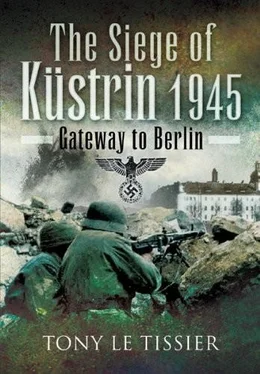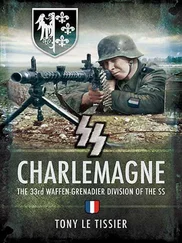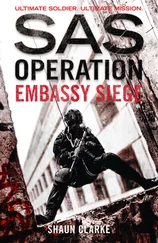Himmler then ordered the Vth SS Mountain Corps based in the Frankfurt-an-der-Oder area to try to block the Soviet advance on Berlin. This was a mixed formation that included the Panzergrenadier Division ‘Kurmark’ and the 21st SS Mountain Division ‘Skanderberg’. The latter was immediately dispatched eastwards to take charge of the Volkssturm units meant to be manning the Tirschtiegel Riegel defences and to absorb any German troops withdrawing in that direction. The ‘Skanderberg’ had the misfortune to reach Zielenzig simultaneously with the Soviet armour, and its commander was wounded and taken prisoner. The armoured reconnaissance battalion of the ‘Kurmark’ set out by rail on 22 January to relieve the Posen garrison but was stopped short of its destination and eventually had to fight its way back, reaching the Oder near Grünberg at the end of the month after many adventures.
Another German infantry division, the ‘Woldenberg’, was apparently meant to form up and fight in the path of the Soviet advance, as this account by Lieutenant Rudolf Schröter indicates:
In 1942 I was badly wounded in an attack in the woods in the Voronesh area east of the Don and lost my lower right arm.
In January 1945 I was a lieutenant commanding a company in an infantry replacement and training battalion under the command of Major Shellack and based on the Strantz Barracks in the East Brandenburg town of Landsberg an der Warthe.
At the end of January there was a sudden alert. I had to see off my wife and little son who were visiting me in the barracks and put them on a truck going west. Then I received orders to form a line of defence against the expected Russians hard east of Landsberg. My sector began on Reichsstrasse 1 at the Oldenburg Experimental Farm (inclusive) and extended some 1.5 to 2 kilometres south to the village of Lorenzdorf. My left-hand neighbour to Irrenanstalt was a unit under Second-Lieutenant Clemens in a situation similar to mine, and my right-hand neighbour an inserted unit of Hungarian Honveds.
I had about 400 recruits at my disposal, some of whom had yet to be sworn in, i.e. mainly youngsters who had just completed their pre-military Hitler Youth training and were at the beginning of their barrack training. Sergeants and NCOs were completely lacking, so these functions were undertaken by recruits with some military knowledge and whose appearance seemed the most suitable. I had no information about our own forces or the enemy.
The temperature on the 28th January was minus 15 degrees Celsius with a thick and frozen blanket of snow. There was great movement to the rear on Reichsstrasse 1 of men on foot and in vehicles. The enemy situation remained quiet, unknown and uncertain, but attacks by advance units could be expected at any time.
A makeshift occupation of the defences was made in and around the farm but there was no infantry for this. However, in front was a twin 20mm flak gun with its crew, its second lieutenant having disappeared. There were also two Hetzers.
That afternoon of the 28th January I administered the oath to those recruits who had not yet been sworn in, in the cover of the farm.
On the morning of the 29th January a sergeant-major of the Waffen-SS reported to me with two Königstigers, two heavy recovery vehicles, a tanker and an amphibious jeep, as well as plenty of ammunition. There was a third Königstiger of his 500 metres from my position that had broken down. My youngsters had to help with the recovery of this vehicle, as the Russians had already probed Lorenzdorf. The recovery succeeded and my escorting infantry were not only highly praised by the tankers, but the sergeant-major decided to support me with his platoon for our cooperation.
Once the vehicles had refuelled in Landsberg, the two recovery vehicles towed the twin 20mm flak gun into a well-covered firing position behind our sector, as well as the two Hetzers and an 88mm flak gun on its trailer that I had acquired from the fleeing columns. Thus all the heavy weapons had taken up secure positions and had good fields of fire in depth in front of our sector and our neighbour’s. My unit was now ready, quietly and confidently awaiting the enemy attack.
During the second half of the 30th January the Russians attacked and took Lorenzdorf. The Hungarians withdrew without concern for us, their left-hand neighbours, without orders or even a ‘good-bye’, but with the fire of our heavy weapons into the flanks of the enemy, we stopped his advance. Then we forced him to withdraw and abandon Lorenzdorf with the reserve and a Königstiger, during which a captured recruit from my company was released.
I still did not know what my superior formation was or who its commander was. Since receiving my orders in the barracks I had not received any further instructions and had no communications with any staff whatsoever. No officer or messenger had sought me out. I only knew that the Russians were attacking and that, since the flight of the Honveds, I now had an almost 3-kilometre-wide open and unprotected flank to the Warthe over which the Russians could renew their attack.
An appreciation of the situation showed that we were surrounded by the enemy, forgotten and lost.
As it was suspected that the town commandant of Landsberg had fled in panic, and that Soviet infantry could infiltrate the town by bypassing us, I decided after consultation with my neighbour and the SS-sergeant-major to withdraw [to] preserve lives and fighting ability…the untrained recruits would also be spared possible house-to-house fighting at night and Landsberg bypassed to the north. This succeeded during the night in deep snow on field and woodland tracks without enemy interference. Clemens’s unit also used the same route to evacuate its position. For the heavy weapons, especially the mechanically incapacitated Königstiger and the recovery vehicles, the only route was by road through Landsberg, if necessary fighting through. The SS, flak and Hetzer crews therefore combined and arranged a rendezvous for the next day between Landsberg and Vietz.
On the morning of the 31st January my unit rejoined the Königstiger SS-sergeant-major about 4 kilometres west of Landsberg in the Wepritz area. As we were still without a superior command or orders, I had us retreat westwards.
Beyond Dühringshof I was met by a car with a general, who received my report. He did not introduce himself, nor did he name his formation. He ordered me to deploy left of the road to Diedersdorf. My left-hand neighbour would be Second-Lieutenant Clemens’s unit. [11]
Sergeant Horst Wewetzer was also involved in the withdrawal along Reichsstrasse 1 to Küstrin, as he relates:
On the 28th January 1945, my birthday, we were deployed on the northern exit from Kreuz in artillery support of Infantry Battalion ‘Schulz’. As we were about to fire our guns at about 0600 hours, the sentry reported to me that the infantry had already withdrawn. That seemed unbelievable to me, as there had still not been any enemy movement. I thought that they had perhaps seen runners, food carriers and wounded. The sentry was convinced, however, and as it appeared, he was correct.
We opened fire without having any infantry protection in front of us and without having been told of this withdrawal. Naturally the Russians fired back and we had one man wounded.
When the tanks rolled through the rows of houses on the parallel street, we could only beat a hasty retreat. We got away from the Russians, crossed a still intact bridge over the Drage and reached Dragebruch, which consisted of only a few houses. Our vehicles stood on the roadway, while the soldiers looked in the houses for something to eat, but the civilian inhabitants had gone, taking all their food with them.
Our troop leader drove off to re-establish contact with the vanished infantry battalion. Then at about 1000 hours the enemy tanks caught up with us. They were as surprised as we were and did not open fire immediately. They first pulled back a little to open fire from a covered position. Our drivers and some of the men jumped into their vehicles and drove about 200 metres on to the edge of a wood to take cover. The other men who had been searching the houses for food ran across the snow-covered open plain, offering perfect targets, to reach the woods, where there was a prepared position already occupied by our troops.
Читать дальше












